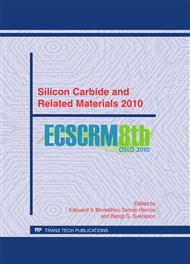p.754
p.758
p.762
p.769
p.777
p.781
p.785
p.789
p.793
The Formation of an Epitaxial-Graphene Cap Layer for Post-Implantation High Temperature Annealing of SiC and its In Situ Removal by Si-Vapor Etching
Abstract:
As a new graphene functionality applicable to post-implantation high temperature annealing of SiC, a method of in situ formation and removal of large area epitaxial few-layer graphene on 4H-SiC(0001) Si-face is proposed. It is demonstrated that the homogeneous graphene layer formed by Si sublimation can be preserved without the decomposition of the underlying SiC substrate even in the excess of 2000 oC in ultrahigh vacuum. It is due to the existence of the stable (6√3×6√3) buffer layer at the interface. To ensure this cap function, the homogeneity of the interface must be guaranteed. In order to do that, precise control of the initial SiC surface flatness is required. Si-vapor etching is a simple and versatile SiC surface pre/post- treatment method, where thermally decomposed SiC surface is compensated by a Si-vapor flux from Si solid source in the same semi-closed TaC container. While this Si-vapor etching allows precise control of SiC etch depth and surface step-terrace structures, it also provides a “decap” function to remove of the graphene layer. The surface properties after the each process were characterized by AFM and Raman spectroscopy.
Info:
Periodical:
Pages:
777-780
Citation:
Online since:
March 2011
Authors:
Price:
Сopyright:
© 2011 Trans Tech Publications Ltd. All Rights Reserved
Share:
Citation:



